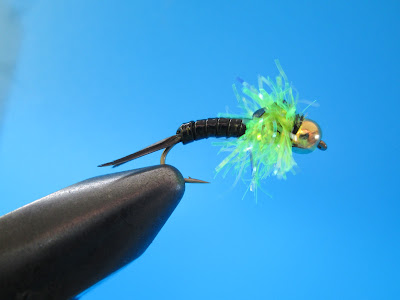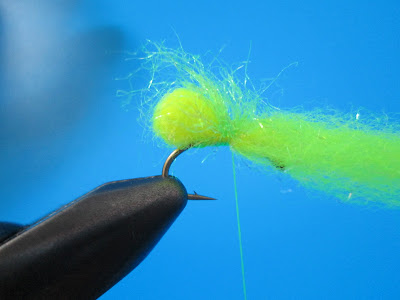The Steel Juan Worm is my variation of the popular Orvis steelhead fly the Eggi Juan Kenobi. The Steel Juan Worm is essentially a san juan worm with an egg in front, like a Egg Sucking Leech. Instead of having a glo-bug egg like the Eggi Juan Kenobi, the Steel Juan Worm has a 6mm Otter's Soft Milking Egg. This is a good steelhead fly for all water conditions, and since it looks different from normal steelhead flies its a good choice for the pressured PA waters.
Hook: MFC no. 7045 size 10
Thread: 6/0 (color to match vernille)
Weight: beadhead (optional)
Body: vernille
Egg: Otter's Soft Milking Egg 6mm
Colors: (vernille/egg) brown/tango, brown/tangerine, red/tango, red/tangerine, pink/tangerine
STEP 1: With a MFC No. 7045 size 10 in your vise, attach your thread and wrap back
past the tie-in-point. (Photo 1A)
 |
| Photo 1A |
Take a 2 1/4in piece of vernille and tie it in so that 3/4in extends past the bend. (Photo 1B)
 |
| Photo 1B |
STEP 2: Advance your thread to the mid-point between the tie-in-point and hook eye. Be sure to leave enough room for the Otter Egg. Bring the vernille forward forming a loop, leaving approx. 3/4in sticking forward.
STEP 3: Now take a 6mm Otter Egg (Tango and Tangerine work good) and push it over the eye of the hook. Bring your thread underneath the egg and make several wraps in front to secure the egg. Whip finish and cut your thread. Your fly is now ready to be fished if you choose not to do the next step.
STEP 4: If you want to you can burn the ends of the vernille with a small lighter. Be careful not to burn to much or burn the egg which will ruin the fly. Remember this step is completely optional, it only makes the fly look a little nicer to the fisherman and has no affect on the steelhead. Please read my warning below.
***Warning***: Since this is Country KIDS on the Fly I am going to make this statement, if you are a kid DO NOT DO THIS STEP WITHOUT IMMEDIATE PARENTAL SUPERVISION!!! Also do not do this in your fly tying area. Fly tying glues are HIGHLY TOXIC and materials are HIGHLY Flammable. Exercise caution.
Well there you have it, a nice steelhead egg/nymph for steelhead. Try it the next time you head out to the creeks. If you catch anything email me, I like to here from fisherman.
 |
| The finished fly. |
 |
| Red worm with Tango/Silver Flash egg. |
 |
| Brown worm with Tango egg. |
 |
| Red worm with Tango egg. |
Tyler Straight
Custom Tied Steelhead Flies
CKOF Website Design

















































